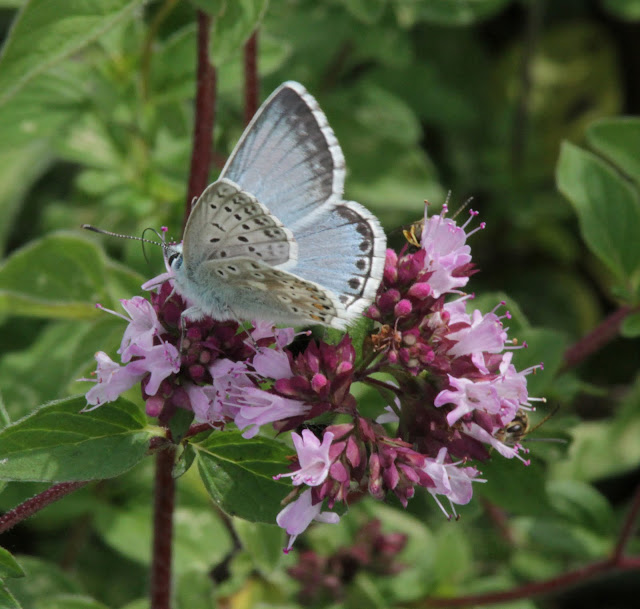I attended the course on Kentish butterflies with Steve Weeks at the Kent Wildlife Trust headquarters at Tyland Barn today, and in the afternoon we all went off to Queendown Warren to put our new-found identification skills into practice!
We got into the swing of things on the more familiar butterflies, checking out the differences between the Meadow Brown and the Gatekeeper, and the Green-veined White and the Small White respectively. Then we got some of the more specialist and rarer prizes on offer and the first species up was a Silver Spotted Skipper, Hesperia comma, one of the descendants of those re-introduced to the Warren after the grazing programme had been disrupted and the old colony there become extinct many years ago. The re-introductions used stock taken from Lydden Down and Temple Ewell nature reserves near Dover, with similar earlier (1997) re-introductions also made to Wye Downs and Burham Down. The re-introduction to Queendown took place about ten years ago and the colony seems to be thriving. they don't fly far from their home colonies, so they need help if they are to spread out to re-occupy more of their former range. Here's one of the results of their reproductive efforts!
and here is another individual from an angle that more clearly shows that this skipper gets its name!
This butterfly looks as though its enjoying the nectar it is sucking up from this knapweed flower-head! The average life-span of an individual is only about 6 days, so they deserve every treat they can get!
The males spend most of their lives watching out for females and the females, once mated, spend most of the time looking for exactly the right clump of Sheep's Fescue, Festuca ovina, to lay their eggs on, while trying to avoid further male attention while they do so. Described as rare in the National Red Data Book these small butterflies are a specific treat wherever their colonies are still found.
The second chalk downland speciality was the Chalkhill Blue, Polyommatus coridon, and there were quite a few nearer the foot of the hill where it was a bit moister and also more sheltered, fluttering around on the lusher patches of marjoram. these were light blue, with some grey edging to the wings and hatching on the white margins.
Scattered amongst the Chalkhill Blues were some Common Blues, Polyommatus icarus, some of them looking a little tatty. These were more overall lilac in colour on the uppersides, with no grey edging and no black hatching on the white edge of the wings.
And then there was the butterfly speciality of this internationally important site, the Adonis Blue, Polyommatus bellargus, and here is a good one I saw just as we all left the reserve main bank at the top of the hill:
We got into the swing of things on the more familiar butterflies, checking out the differences between the Meadow Brown and the Gatekeeper, and the Green-veined White and the Small White respectively. Then we got some of the more specialist and rarer prizes on offer and the first species up was a Silver Spotted Skipper, Hesperia comma, one of the descendants of those re-introduced to the Warren after the grazing programme had been disrupted and the old colony there become extinct many years ago. The re-introductions used stock taken from Lydden Down and Temple Ewell nature reserves near Dover, with similar earlier (1997) re-introductions also made to Wye Downs and Burham Down. The re-introduction to Queendown took place about ten years ago and the colony seems to be thriving. they don't fly far from their home colonies, so they need help if they are to spread out to re-occupy more of their former range. Here's one of the results of their reproductive efforts!
and here is another individual from an angle that more clearly shows that this skipper gets its name!
This butterfly looks as though its enjoying the nectar it is sucking up from this knapweed flower-head! The average life-span of an individual is only about 6 days, so they deserve every treat they can get!
The males spend most of their lives watching out for females and the females, once mated, spend most of the time looking for exactly the right clump of Sheep's Fescue, Festuca ovina, to lay their eggs on, while trying to avoid further male attention while they do so. Described as rare in the National Red Data Book these small butterflies are a specific treat wherever their colonies are still found.
The second chalk downland speciality was the Chalkhill Blue, Polyommatus coridon, and there were quite a few nearer the foot of the hill where it was a bit moister and also more sheltered, fluttering around on the lusher patches of marjoram. these were light blue, with some grey edging to the wings and hatching on the white margins.
Scattered amongst the Chalkhill Blues were some Common Blues, Polyommatus icarus, some of them looking a little tatty. These were more overall lilac in colour on the uppersides, with no grey edging and no black hatching on the white edge of the wings.
And then there was the butterfly speciality of this internationally important site, the Adonis Blue, Polyommatus bellargus, and here is a good one I saw just as we all left the reserve main bank at the top of the hill:





No comments:
Post a Comment